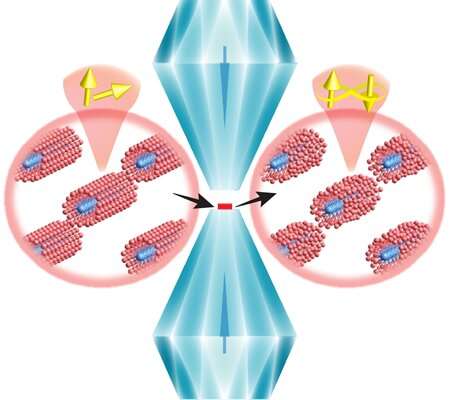Researchers discover superconductor with unexpected lattice configuration

An international team has discovered that compressing monocrystalline (TaSe4)2I can create a system where the constituent TaSe4Q1-D atomic chains are in amorphous state without breaking the orientational and periodic translation symmetries of the chain lattice. Moreover, they found that along with the amorphization of the atomic chains, the insulating (TaSe4)2I becomes a superconductor.
The team is led by Prof. Yang Zhaorong from the High Magnetic Field Laboratory, Hefei Institutes of Physical Science and Prof. Zhang Gufei from University of Southern Denmark.
In this study, they used monocrystalline (TaSe4)2I as the starting material for the realization of a new quasi-1-D phase with advanced electronic properties.
When increasing the applied pressure up to ca. 20 GPa, they realized the amorphization of the constituent atomic chains of (TaSe4)2I without breaking the long-range order of the chain lattice.
Crystalline and amorphous structures are two of the most common solid-state phases. Crystals having orientational and periodic translation symmetries are usually both short-range and long-range ordered, while amorphous materials have no long-range order. Short-range ordered but long-range disordered materials are generally categorized into amorphous phases.
In contrast to the extensively studied crystalline and amorphous phases, the combination of short-range disordered and long-range ordered structures at the atomic level is extremely rare and so far has only been reported for solvated fullerenes under compression.
The as-prepared material with a combination of short-range disorder and long-range order demonstrates a new solid-state phase other than conventional crystalline or amorphous structures.
Furthermore, upon the amorphization of the atomic chains, superconductivity emerges in the newly created system. This counterintuitive phenomenon brings attention to the Cooper pairing in quasi-1-D materials disordered at the atomic level.
The study provides critical insight into a new phase of solid-state materials. In addition, the present findings demonstrate a first ever case where superconductivity is hosted by a lattice with periodic but amorphous constituent atomic chains.
More information: Chao An et al. Long‐Range Ordered Amorphous Atomic Chains as Building Blocks of a Superconducting Quasi‐One‐Dimensional Crystal, Advanced Materials (2020). DOI: 10.1002/adma.202002352
Journal information: Advanced Materials
Provided by Chinese Academy of Sciences





















